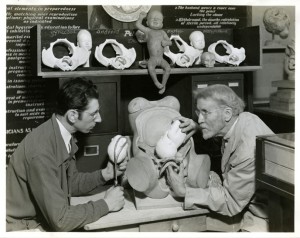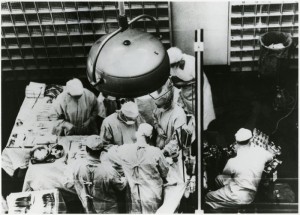
Robert Latou Dickinson
While processing the Robert Latou Dickinson papers, Center staff came across photographs of Robert Latou Dicksinon and artist Abram Belskie in their studio at the New York Academy of Medicine.
After retirement from medical practice, Dickinson collaborated with Belskie at the New York Academy of Medicine to create molds and models of human reproductive anatomy for display and as teaching aids, some of which were exhibited at World’s Fair in 1939. These models were later featured in the teaching book Birth Atlas. The sculptures Norma and Normman were a product of their collaboration as well. In 1945, Dickinson transferred his reproductive anatomy model collection to the Cleveland Health Museum. In 2007 the Health Museum was absorbed into the Cleveland Museum of Natural History and at that time transferred the Dickinson-Belskie collection to the Warren Anatomical Museum.
Below are photographs of Dickinson and Belskie in studio with their teaching models, from the Dickinson papers. The photographs were originally produced for Look Magazine; the Library of Congress now holds the copyright for the images. (LOOK Magazine Photograph Collection, Library of Congress, Prints & Photographs Division)
The Dickinson-Belskie Collection in the Warren Anatomical Museum (object numbers 20500-20778) is available for research. Advance notice is required.
The finding aid for the Dickinson papers can be found here.
For information regarding access to these collections, please contact the Public Services staff.
-

-
Dickinson
-

-
Dickinson, left, and Belskie
-

-
Belskie, left, and Dickinson
-

-
Dickinson and students
-

-
From left, Belskie, Secretary Miss Shirk, Dickinson
-

-
Dickinson

Vietnam War Protestors
While processing the papers of Mark Rosenberg, center staff came across records related to Rosenberg’s activities as a photographer. As a undergraduate at Harvard, Rosenberg was a photographer for the Harvard Crimson and later on his work appeared in the Harvard Alumni Bulletin and the Harvard Medical Alumni Bulletin. He accompanied anthropologist and Harvard University faculty member Evon Vogt to Mexico as a photographer as part of the Harvard Chiapas Project. From 1978 to 1980, he was a Tutor in Photography at Radcliffe College.
Starting in 1976, Rosenberg worked on a project to document the human side of injury and illness, as contrasted with the coldness and sterility of medical technology. In his book, Patients: the Experience of Illness (1980), he combined photographs and interviews to show the effects of illness on the lives of six people with different diseases. In an interview after the publication of Patients, Rosenberg discussed the intersection of medicine and photography:
Pictures of sick people are conspicuous by their absence and the segregation of the seriously ill into hospitals and nursing homes ensures that most of us will never see ‘the real thing’. An unfortunate consequence of keeping illness under wraps is that we might come to think that sick people are too horrifying to look at. And if we can’t look at them, we certainly can’t talk to them. In the end, we may leave patients unable to talk about their illnesses with family or friends just when they are most in need of support.
A selection of Rosenberg’s photographs from the collection can be seen below.
Rosenberg (B.A., 1967, Harvard College; M.D., 1972, Harvard Medical School) was President and Chief Executive Officer of the Task Force for Global Health (1999-2016) and worked at the Centers for Disease Control and Prevention (CDC) (1980-1999), helping to establish the CDC’s National Center for Injury Prevention and Control and serving as the first Director (1994-1999).
The processing of the Rosenberg papers is nearing completion and the finding aid will be available soon. For information regarding access to this collection, please contact the Public Services staff.
-

-
Robert F. Kennedy
-

-
HMS Dean Daniel Tosteson
-

-
Soccer Match
-

-
HMS Dean for Faculty Affairs Eleanor Shore
-

-
Mayan man from Zinacantan
-

-
Kresge Building, Harvard School of Public Health
-

-
Mayan child from Zinacantan
-

-
Children with dog
-

-
HMS Dean Robert Ebert

Joseph E. Murray
The Center for the History of Medicine is pleased to announce the opening of the Joseph E. Murray papers, 1919-2011. The papers are the product of Murray’s activities as a plastic surgeon, transplant surgeon, laboratory director, author, and Harvard Medical School alumnus, and include records from Murray’s plastic surgery and transplantation work at the Peter Bent Brigham Hospital and Children’s Hospital Boston. The collection also contains his personal and professional correspondence, records from his activities as chairman of the Harvard Medical Alumni Fund, records from reunions of the Harvard Medical School class of 1943b, as well as Murray’s professional writings.
Joseph E. Murray (1919-2012), A.B., 1940, College of the Holy Cross, Worcester, Massachusetts; M.D., 1943, Harvard Medical School, Boston, Massachusetts, transplant and plastic surgeon, received the 1990 Nobel Prize in Physiology or Medicine for his work on organ transplantation. Murray served as Head of the plastic surgery departments at Peter Bent Brigham Hospital and Children’s Hospital Boston, Chief of Transplant Surgery at Peter Bent Brigham Hospital, and Director of the Surgical Research Laboratory at Harvard Medical School. In 1954, Murray performed the first successful human organ transplantation, between identical twins, Ronald (donor) and Richard (recipient) Herrick, at the Peter Bent Brigham Hospital.
The finding aid for the collection can be found here.
For information regarding access to this collection, please contact the Public Services staff.
Links to previous blog posts on Joseph Murray:
In Memoriam: Joseph E. Murray, 1919-2012
Staff Finds: Joseph Murray and the Surgical Research Laboratory
Joseph Murray on the First Successful Human Organ Transplant

Dr. Joseph Murray
The current issue of Harvard Medicine features an essay by Dr. Joseph Murray reflecting on the first successful organ transplantation. Murray discusses how his service as an army surgeon during World War II helped influence the direction of his career, as well as describing the procedure and its aftermath. The transplant involved numerous surgical risks, but also raised additional issues:
This list of potential risks posed an ethical dilemma for us. While we routinely asked patients to incur some risk in order to achieve a benefit for themselves, none of us had ever asked a healthy person to accept this magnitude of risk solely for the sake of someone else. We consulted with experienced physicians within and outside of the Brigham, clergy of all denominations, and legal counsel before offering the option of transplantation. The team met several times with the family to describe in detail what was involved for Ronald and Richard. We advised neither for nor against the operation, and we stated the obvious: We could not know if it would work.
Joseph Murray (B.A., 1940, Holy Cross College, M.D., 1943, Harvard) was Professor of Surgery at Harvard Medical School and Chief of Plastic Surgery at Brigham Hospital and Children’s Hospital. He received the Nobel Prize in Physiology or Medicine 1990, for his work on organ transplantation. The Center holds the Joseph E. Murray Papers, 1919-1999. For information regarding access, please contact the Public Services staff.

Joseph Murray (third from left), performing the first successful organ transplant at the Peter Bent Brigham Hospital, Boston, MA, December 23, 1954.
UPDATE: The Harvard Gazette interviewed Dr. Murray about the 1954 transplant as part of a series celebrating Harvard’s 375th anniversary.

Carl Gustav Jung
The Center for the History of Medicine is happy to announce that the audio recordings of the C. G. Jung Biographical Archive have been digitized and are now available to researchers. Previously accessible only in transcript form, the collection consists of 181 interviews with Jung’s family, friends, colleagues, and contemporaries. The interviews, which took place from 1968 to 1972, were funded by the Francis G. Wickes Foundation and were conducted by Dr. Gene F. Nameche. The collection was donated to the Francis A. Countway Library of Medicine in 1972. A mentee of Sigmund Freud, Jung was a leader in dream analysis and is credited with founding the field of analytical psychology.
Due to restrictions set by the interviewees, some interviews are closed to access. In addition, access to the entire collection is restricted to onsite use only. For more information regarding access, please contact the Public Services staff.
The digitization of the Jung Biographical Archive was supported by the Carl Gustav Jung Fund, created at the time of the collection’s donation to ensure its longterm research use and accessibility.




















